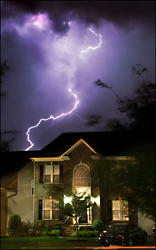 As its name suggests, the National Fire Protection Association’s goal is to protect against fires. It is therefore not surprising that the number of fires involving corrugated stainless steel gas tubing over the last few years has caught the NFPA’s attention. In the fall of 2009, the NFPA formed a CSST Task Group. The Task Group was entrusted with the job of taking a closer look CSST’s potential for failure when confronted with energy from direct and indirect lightning strikes. The CSST Task Group has now met, submitted a report and has been discharged.
As its name suggests, the National Fire Protection Association’s goal is to protect against fires. It is therefore not surprising that the number of fires involving corrugated stainless steel gas tubing over the last few years has caught the NFPA’s attention. In the fall of 2009, the NFPA formed a CSST Task Group. The Task Group was entrusted with the job of taking a closer look CSST’s potential for failure when confronted with energy from direct and indirect lightning strikes. The CSST Task Group has now met, submitted a report and has been discharged.
Only time will tell, but the CSST Task Group report may have a far ranging impact in both the construction and CSST industries. First, one of the main issues that the Task Group reviewed was whether bonding of CSST, as set forth in the present edition of the National Fuel Gas Code (NFPA 54), was enough to prevent lightning-induced CSST fires. The Task Group reports that it sought research supporting the continued use of the current CSST bonding requirements of NFPA 54. To this end, the Task Group specifically asked manufacturers of CSST to provide research performed by them on their behalf in this regard. The information the Task Group received in response was of “limited value” and “did not provide enough information to ascertain that the proposed bonding remedy will provide adequate protection from lightning induced surges.” The minutes of the Task Group meeting further reveal that at least one of the members observed failed CSST gas lines even in instances where the CSST was bonded per NFPA 54 and the manufacturer’s recommendation.
As a result of the Task Group’s work, the NFPA has decided that further review of CSST is warranted before the next version of NFPA 54 is published in 2014. Among other things, the NFPA is now looking to validate whether bonding of CSST is an adequate solution to the lightning exposure problem or if there are other alternative methods of installation that will make the product safe.
Could this be the end of CSST as means of delivering gas products? Or, could this be the start of a movement to make CSST a genuinely safe product? The NFPA appears serious about making sure this product is safe. An Action Report dated June 23, 2010 concluded with these words of warning:
Over the next full revision [of NFPA 54] currently scheduled to be in the Annual 2014 revision cycle, the industry and others advocating the continued use of CSST in gas piping systems shall validate the safe use of the product through independent third-party validated research and testing that can be reviewed and evaluated by the standards developers in a timely way… [I]t is incumbent upon the manufacturers or others promoting the use of CSST in gas piping systems to provide independently validated and reliable technical substantiation demonstrating the CSST can safely be used. If such substantiation is not provided, the Technical Committee on the National Fuel Gas Code must consider prohibited the use of CSST in NFPA 54. In addition, should the issues not be reasonably addressed by the end of the next full revision cycle, Annual 2014, the Council may take action as it deems appropriate up to and including prohibition of the use of CSST in NFPA 54.
For many who have already lost their homes due to lightning-induced CSST fires, these developments have already come too late. But for now, NFPA appears poised to act. Hopefully, we all will be safer for it.



